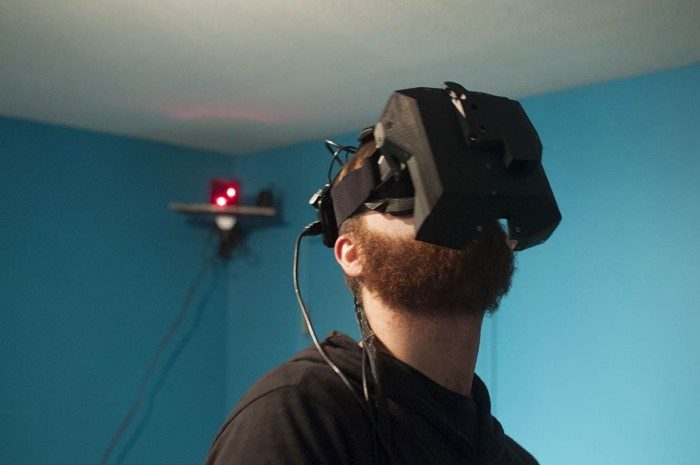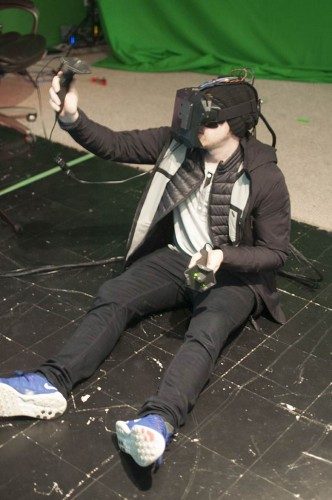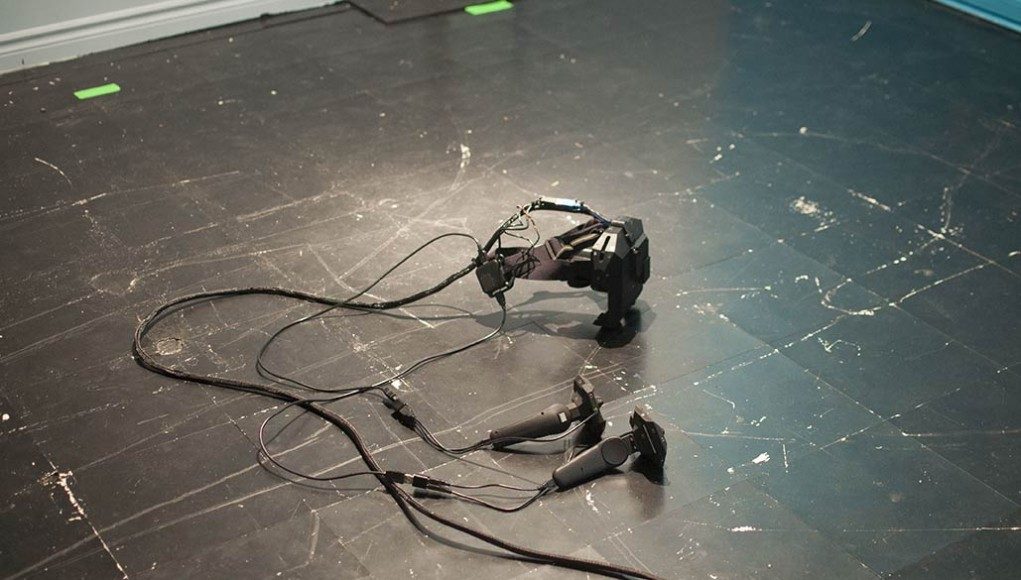With just two months to work with early and constantly evolving hardware from Valve, Cloudhead Games had a challenge before them: create a SteamVR-ready demo in time for the HTC Vive reveal at GDC 2015. Denny Unger, President & Lead Creative Director of Cloudhead Games, tells us what the company has learned about developing for SteamVR during this dev sprint, and also conveys a strong affinity for the system’s capabilities.

As VR game developers go, Denny Unger’s studio, Cloudhead Games, is about as old as they come. The studio launched a Kickstarter for their forthcoming title, The Gallery: Six Elements, at the beginning of March, 2013, about a month prior to the first Oculus Rift DK1 units shipping out to developers.
The studio began production after raising 127% of their $75,000 goal for a Myst-like VR puzzle-exploration game. From the beginning, the studio’s focus was on the immersive capability of the Oculus Rift, and there was a clear vision of intuitive input (beyond a controller or keyboard) using something like the now discontinued Razer Hydra motion input controller. Given that the game was developed alongside the Oculus Rift and other up-and-coming VR hardware, it wasn’t clear exactly which combination of VR headset and input device would fit the game’s immersive goals. Until now.
Two years post-Kickstarter, the studio’s VR development expertise was plain enough to see that Cloudhead was invited to what Unger called “Valve’s secret summit” at the end of 2014, a ‘hush hush’ gathering of a handful of VR developers wherein Valve privately revealed a prototype version of their impressive SteamVR system. In January, the developers received the prototype to begin work creating demos for the platform that became the talk of the town at GDC 2015 earlier this month.

“The initial hardware was very prototype, 3D printed and raw. We were getting gear as fast as the guys at Valve could print it out and glue it together!” Unger told me. And while it was exciting to see the evolution of the prototype, it added an extra challenge atop the mere two month window that Cloudhead had to create a show-ready demo that would accompany the reveal of SteamVR and the HTC Vive.
See Also: HTC Vive and SteamVR Hands-on – A Stage of Constant Presence
“It was great to see the iteration happening but it was also a tremendous challenge as SteamVR was in a constant state of development to match the new hardware. So as a consequence, our build for the demo was constantly changing to match little tweaks that occurred as a result of that iteration.”
But the challenge paid off; by the time that the studio received the HTC Vive dev kit toward the end of their two month sprint, the studio finally had a clear vision of what platform their game could ship with.
“As it stands currently we have assurances from Valve/HTC on release timelines and a stable minimum spec that we can build towards. We know what the hardware can do and when it will be available to the public,” said Unger. “So from that standpoint any studio that is serious about VR now has a rock solid solution to hitch their production schedule to. That’s a breath of fresh air for anyone who has been in this space from the beginning.”

And from the sound of it, Unger and co. have been mighty impressed with the system.
“Lay on the floor if you want, jump around, crawl, use both hands to juggle or put together a puzzle, the system doesn’t care, it just works! It’s the key thing that makes buzzwords like “Presence” mean something tangible.” Unger told me. “And you can’t do it half way either, Presence does not live without giving people an intuitive way to interact with the world around them. You need those things to ground people in the experience, in their avatar, in the world. Everything else might feel right in other systems until you’ve had a chance to try it as it should be, then there’s no going back.”
Though the studio only had two months to develop a demo experience for the system, the work of the past two years served as a good head start. Below you can see the full Gallery SteamVR / HTC Vive demo gameplay:
“Fortunately, a number of the systems we had already designed for The Gallery: Six Elements did translate. Everything to do with manipulating, constraining and interacting with objects using your hands came over to the Vive without too much fuss,” Unger said. “Because the fidelity of the system is so high, it smoothed out a number of things that we previously didn’t have the tracking quality for—catching is a good example of that.”
However, Unger told me that there were (and still are) challenges associated with moving from a seated experience to one where players can not only physically walk around a large space, but also reach out and interact with the world.
 “Accounting for [the physical play area], total positional tracking created some challenges with respect to our previous body persistence systems. Elbow hinting and body position in a volumetric space, where a user can stand, crouch, and lay on the ground, are new challenges. And with three points of tracking it’s a major challenge to get right,” he said. “So in the end we deferred to hands because we didn’t have time to implement our simulated root tracking system.”
“Accounting for [the physical play area], total positional tracking created some challenges with respect to our previous body persistence systems. Elbow hinting and body position in a volumetric space, where a user can stand, crouch, and lay on the ground, are new challenges. And with three points of tracking it’s a major challenge to get right,” he said. “So in the end we deferred to hands because we didn’t have time to implement our simulated root tracking system.”
While all of the SteamVR / HTC Vive demos shown thus far placed users in a static environment, the studio’s vision for The Gallery requires being able to locomote players beyond their physically limited walking pace. Cloudhead and others are experimenting, but it’s still an unsolved challenge.
“The end goal is to create a holistic solution that works for seated, standing 360, and full room-scale experiences. The user should be able to switch between these modes at will. And because users will have variable space constraints, our locomotion system has to scale to any useable size,” Unger said.
“We aren’t there yet but lessons learned from creating ‘VR Comfort Mode’ will help to avoid discomfort, or at least understanding what not to do when driving the space. Forward moving velocities are pretty safe as a rule (as are vertical) as long as you don’t scale them unrealistically and the user is completely in charge of driving the input. Ultimately locomotion solutions will always come down to preference and I think providing users with options will be important until the language of full room-scale locomotion is established.”
Despite the challenges of designing for a player that has so much freedom of movement and interaction, Unger is incredibly enthusiastic about the platform.
“For us, the Vive hardware helped us realize a pretty stubborn dream we’ve had from the beginning on The Gallery. The complete freedom to move around unconstrained, using your hands in a completely natural way, is VR wish fulfillment,” he said.
Now that Unger has had his “VR wish” fulfilled, I can’t wait to see what the studio dreams up next.







